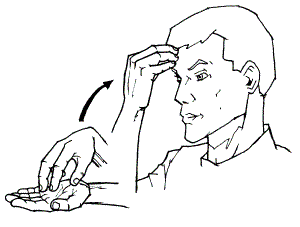Signs for aviation, numbers, and emotions
April 28th, 2023 at 12:51 pm (Language)
Our American Sign Language class continues to build vocabulary and learn new things.
One of my favorite parts of the class is at the beginning when Dr. Eleweke asks us “HOW YOUR WEEKEND?” We don’t have enough ASL vocabulary to answer, so we type our answers in the chat and he teaches us the relevant signs on the spot. So at the start of our last class, I got to learn how to sign “ME PILOT” and “FLYING CLUB WASH PLANES”.
The sign for PILOT that we learned is FLY+PERSON (like teacher is TEACH+PERSON and student is LEARN+PERSON). The hand sign for FLY/PLANE is, charmingly, like the sign for “I love you” but held horizontally (and you get to zip it around to show the plane flying :) ). The PERSON (-ER) ending is a downward gesture with both hands held like blades in front of you. I also see that some people sign it as FLY/PLANE+DRIVER.
We learned a couple of signs for WASH, which allows you to distinguish between washing your hands (rubbing them against each other) versus washing a large wall or window (or airplane) (scrubbing an invisible large surface in front of you). For “FLYING CLUB” we had FLY plus C-shape hands making a circle in front of us, I think denoting a group of people.
Then in the lesson itself, we learned the numbers from 1-99.
Me: “What about 100?”
Dr. Eleweke: “We’ll do 100 next time. You are overlearning, ha ha!”
Double-digit numbers (22, 33, …) are signed with the same digit bounced to the left and right. Numbers that have two different digits from the range 6-9 (e.g., 67, 86, 98) are “rocking” numbers where you rock your hand from side to side so these digits are easier to distinguish. Curiously, you don’t do left-right for the first-second digit but instead “higher” for the larger digit and “lower” for the smaller digit. So for me, signing with my right hand, it’s 6-low/right + 7-high/left for 67 and 9-high/left + 6-low/right for 96. A little mind-bending!
Learning 1-99 seemed like the perfect opportunity to learn and practice things like “how old are you?” and generate personal answers, but this didn’t happen. Trying to think of ways to practice numbers, I did manage to interject “ME HAVE 7 NIECES, NEPHEWS” and I was thrilled that he understood me!
Next we learned several adjectives so we can answer HOW-YOU? and HOW YOU FEEL? These words include FINE, GOOD, HUNGRY, TIRED, HAPPY, ANGRY, EXCITED, PASSIONATE, SAD, CRANKY, ANXIOUS, SCARED, SICK, STRESSED, CONFUSED, CALM, HEALTHY, PATIENT, BUSY, FEEL STRONG, WEAK. Lots to practice before next time!
 Recently I discovered
Recently I discovered 